7. New Approaches in the Treatment of Osteoarthritis
Belén Cuervo, Mónica Rubio, Ramón Cugat, Montserrat García-Balletbó, Elena Damiá, Joaquín J Sopena, Jose Mª Carrillo
Degenerative joint disease, also known as osteoarthritis, is currently one of the most prevalent and morbid diseases due to an increase in both life expectancy and obesity. Moreover, due to its severity and irreversibility, osteoarthritis causes a severe social and economic impact around the world due to the loss in quality of life and productivity. Osteoarthritis is known to be a multifactorial disease, where several risk factors have been already described, leading to temporary and progressive structural changes within joint tissues, especially in joint cartilage, subchondral bone, synovial membrane and synovial liquid, causing the main clinical symptoms such as chronic pain, joint instability, stiffness and joint space narrowing. The use of advanced therapies for treating this disease is guided to a regenerative medicine aimed to encourage the regenerative or restorative methods, being a new alternative to more aggressive treatments. Within these treatments we can find platelet-rich plasma (PRP) and mesenchymal stem cells (MSC). PRP is an autologous novel therapeutic tool that has risen strongly in the past few years and has several applications within the medical field. It is defined as a biological product derived from the own patient’s blood, obtaining a plasma fraction after a centrifugation process with a platelet concentration greater than the existing in the circulatory system. Many of the factors contained in the interior of PRP have specific activity of neoproliferation and cartilage regeneration. There are increasing studies regarding MSC and osteoarthritis treatment, especially in relation to MSC derived from adipose tissue. These cells have shown its capacity to differentiate into chondrocytes, osteocytes and adipocytes, as well as their advantage that they can be obtained in bigger quantities with little morbidity to the donor site and reduced discomfort to the patient. It has been confirmed that autologous MSC have great affinity for the injured tissue of the joint, being able of localizing and participating in repair of structures of the injured joint.




